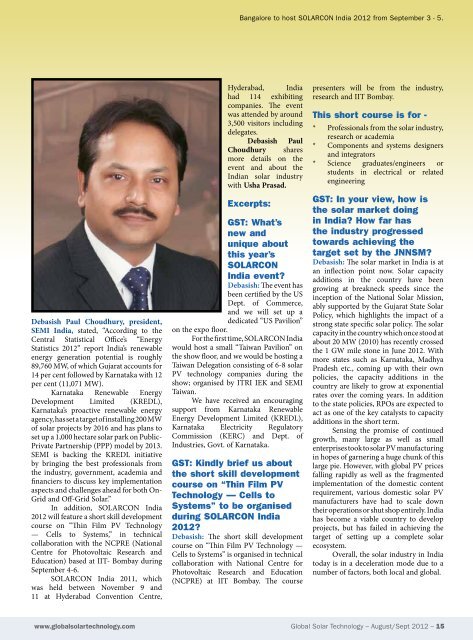Magazine SEA 3.5 Edition - Global Solar Technology
Magazine SEA 3.5 Edition - Global Solar Technology
Magazine SEA 3.5 Edition - Global Solar Technology
You also want an ePaper? Increase the reach of your titles
YUMPU automatically turns print PDFs into web optimized ePapers that Google loves.
Debasish Paul Choudhury, president,<br />
SEMI India, stated, “According to the<br />
Central Statistical Office’s “Energy<br />
Statistics 2012” report India’s renewable<br />
energy generation potential is roughly<br />
89,760 MW, of which Gujarat accounts for<br />
14 per cent followed by Karnataka with 12<br />
per cent (11,071 MW).<br />
Karnataka Renewable Energy<br />
Development Limited (KREDL),<br />
Karnataka’s proactive renewable energy<br />
agency, has set a target of installing 200 MW<br />
of solar projects by 2016 and has plans to<br />
set up a 1,000 hectare solar park on Public-<br />
Private Partnership (PPP) model by 2013.<br />
SEMI is backing the KREDL initiative<br />
by bringing the best professionals from<br />
the industry, government, academia and<br />
financiers to discuss key implementation<br />
aspects and challenges ahead for both On-<br />
Grid and Off-Grid <strong>Solar</strong>.”<br />
In addition, SOLARCON India<br />
2012 will feature a short skill development<br />
course on “Thin Film PV <strong>Technology</strong><br />
— Cells to Systems,” in technical<br />
collaboration with the NCPRE (National<br />
Centre for Photovoltaic Research and<br />
Education) based at IIT- Bombay during<br />
September 4-6.<br />
SOLARCON India 2011, which<br />
was held between November 9 and<br />
11 at Hyderabad Convention Centre,<br />
www.globalsolartechnology.com<br />
Hyderabad, India<br />
had 114 exhibiting<br />
companies. The event<br />
was attended by around<br />
3,500 visitors including<br />
delegates.<br />
Debasish Paul<br />
Choudhury shares<br />
more details on the<br />
event and about the<br />
Indian solar industry<br />
with Usha Prasad.<br />
Excerpts:<br />
GST: What’s<br />
new and<br />
unique about<br />
this year’s<br />
SOLARCON<br />
India event?<br />
Debasish: The event has<br />
been certified by the US<br />
Dept. of Commerce,<br />
and we will set up a<br />
dedicated “US Pavilion”<br />
on the expo floor.<br />
For the first time, SOLARCON India<br />
would host a small “Taiwan Pavilion” on<br />
the show floor, and we would be hosting a<br />
Taiwan Delegation consisting of 6-8 solar<br />
PV technology companies during the<br />
show; organised by ITRI IEK and SEMI<br />
Taiwan.<br />
We have received an encouraging<br />
support from Karnataka Renewable<br />
Energy Development Limited (KREDL),<br />
Karnataka Electricity Regulatory<br />
Commission (KERC) and Dept. of<br />
Industries, Govt. of Karnataka.<br />
GST: Kindly brief us about<br />
the short skill development<br />
course on “Thin Film PV<br />
<strong>Technology</strong> — Cells to<br />
Systems” to be organised<br />
during SOLARCON India<br />
2012?<br />
Debasish: The short skill development<br />
course on “Thin Film PV <strong>Technology</strong> —<br />
Cells to Systems” is organised in technical<br />
collaboration with National Centre for<br />
Photovoltaic Research and Education<br />
(NCPRE) at IIT Bombay. The course<br />
Bangalore to host SOLARCON India 2012 from September 3 - 5.<br />
presenters will be from the industry,<br />
research and IIT Bombay.<br />
This short course is for -<br />
* Professionals from the solar industry,<br />
research or academia<br />
* Components and systems designers<br />
and integrators<br />
* Science graduates/engineers or<br />
students in electrical or related<br />
engineering<br />
GST: In your view, how is<br />
the solar market doing<br />
in India? How far has<br />
the industry progressed<br />
towards achieving the<br />
target set by the JNNSM?<br />
Debasish: The solar market in India is at<br />
an inflection point now. <strong>Solar</strong> capacity<br />
additions in the country have been<br />
growing at breakneck speeds since the<br />
inception of the National <strong>Solar</strong> Mission,<br />
ably supported by the Gujarat State <strong>Solar</strong><br />
Policy, which highlights the impact of a<br />
strong state specific solar policy. The solar<br />
capacity in the country which once stood at<br />
about 20 MW (2010) has recently crossed<br />
the 1 GW mile stone in June 2012. With<br />
more states such as Karnataka, Madhya<br />
Pradesh etc., coming up with their own<br />
policies, the capacity additions in the<br />
country are likely to grow at exponential<br />
rates over the coming years. In addition<br />
to the state policies, RPOs are expected to<br />
act as one of the key catalysts to capacity<br />
additions in the short term.<br />
Sensing the promise of continued<br />
growth, many large as well as small<br />
enterprises took to solar PV manufacturing<br />
in hopes of garnering a huge chunk of this<br />
large pie. However, with global PV prices<br />
falling rapidly as well as the fragmented<br />
implementation of the domestic content<br />
requirement, various domestic solar PV<br />
manufacturers have had to scale down<br />
their operations or shut shop entirely. India<br />
has become a viable country to develop<br />
projects, but has failed in achieving the<br />
target of setting up a complete solar<br />
ecosystem.<br />
Overall, the solar industry in India<br />
today is in a deceleration mode due to a<br />
number of factors, both local and global.<br />
<strong>Global</strong> <strong>Solar</strong> <strong>Technology</strong> – August/Sept 2012 – 15
















